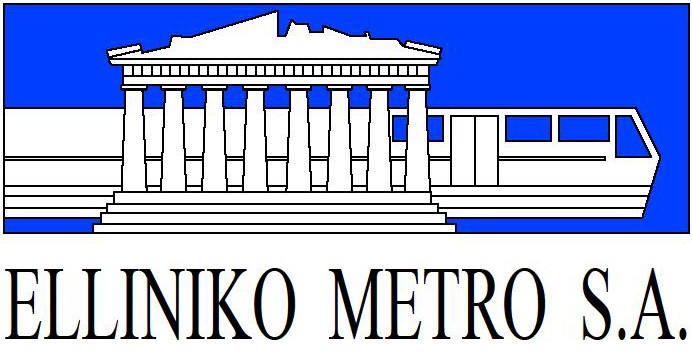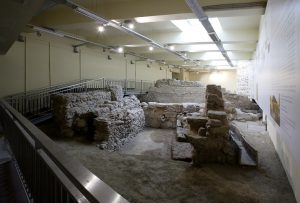The most significant archaeological excavations were performed during the first phase of the Project’s construction in four Metro stations located in the Historic Center of the city of Athens: SYNTAGMA, KERAMIKOS, MONASTIRAKI and AKROPOLI Stations. Over twenty archaeological excavations in stations and ventilation shafts were carried out in total. The depth of the archaeological “layers” varied between 0.5m to 7.0m; however, certain “hydraulic” structures, such as wells, ducts, reservoirs and aqueducts were revealed at greater depths, i.e. from 15.0m to 45m. The antiquities revealed were recorded in detail and were surveyed using modern techniques under the scientific guidance of the concerned Services of the Ministry of Culture (MoC).
There follows a brief presentation of the archaeological finds revealed in the four stations of the historic center:
In SYNTAGMA Station, a sculpture foundry dating from the Classic Era, a cemetery dating back to the sub-Mycenaean and the Byzantine times, baths complex dating back to the roman times, a section of the Peisistranian Aqueduct, the bed of Iridanos River and the ancient road leading from the gates of the wall to the municipalities of Messogaia.
Near KERAMIKOS Station, a section was revealed of the most significant cemetery of the ancient city of Athens. 1200 graves dating back to the beginning of 7th century BC up to roman times were examined. Moreover, the two burial grounds, dating back to the beginning of the Peloponnesian War, constitute a significant archaeological find. The western surrounding wall of the cemetery, remains of the workshop of ceramic art and the bed of Iridanos River were also revealed.
Another significant archaelogical site revealed through the construction of MONASTIRAKI station. Τhe embedded bed of Iridanos River is one out of the most significant finds of MONASTIRAKI Station. It was confirmed that the area had been in constant use from the Mycenaean Era up to modern times. Buildings, workshops, graves and a variety of water supply and sewage systems were revealed. For the Metro construction in the area of MONASTIRAKI, archaeological excavations were carried out and residential remains came to light dating back to the 8th century BC (Geometric Era) up to the 19th century AD.The basic axis of the town planning in all eras was Iridanos River. Iridanos River had its springs at the foot of Lycabettus, it run through Athens and flowed into Ilissos River.
The course of the river was incessant and used to increase during heavy rainfalls. During the Post-Classical Ear (5th – 4th century BC) large conglomerate stones delimited the riverbed, 2.60m wide. Two paths, on the north and south-hand side, set the limits of the building line for the buildings, which commenced to be built on either side of the river. In the era of Adrianos Emperor (117 to 138 AD) Iridanos River was covered with a vault made of bricks, then it was backfilled and turned into a sewer. A large retaining wall was built at the northern boundary of the river in order to retain a wide gallery or a road, while the building line receded by 4.50m. The buildings belonged to private citizens, workshops and warehouses. The remains were dated based on numerous and various finds: marble sculptures and architectural members, mosaic floors, wall paintings (fresco), decorative graved plastering, pots and coins, metal and bone-made objects.
The excavation survey in ACROPOLIS Station carried out over an area of 2500 m2 showed that this area had been used since the end of the 3rd millennium BC up to the Byzantine times. A few graves of the Middle-Helladic and Post-Helladic Era, houses, workshops, roads and baths were also revealed.
Apart from the four stations located in Athens historic center, significant finds were also encountered in other locations as well, such as:
- in EVANGELISMOS Station: an ancient cemetery with the cemetery surrounding wall, a Peisistranian duct and a road;
- in PANEPISTIMIO Station: an ancient cemetery
Significant antiquities were also found in the ventilation shafts, i.e.:
- in “Irodou Attikou” Shaft: a roman house, a cemetery and hydraulic systems;
- in “Amalias” Shaft: a roman bath of significant importance;
- in “Mitropoleos” Shaft: significant building remains;
- in “Petmeza” Shaft: a cemetery dating back to the Classic up to the Byzantine times, as well as a room supported on columns;
- in “Fokionos” Shaft: a building dating back to the roman era and Byzantine storing facilities;
- in “Thissio” Shaft: a building dating back to the Post Classic times and workshops;
- in “Ermou – Arionos” Shaft: workshop areas and hydraulic systems;
- in “Iachou” Shaft: an ancient cemetery;
- in “Assomaton” Shaft: a building of significant importance.
The boring of the tunnels was performed under constant archaeological monitoring and brought to light several ancient wells hiding significant archaeological finds, as well as a section of Adrianion Aqueduct. Apart from the collection and preservation of hundreds of thousands of archaeological articles in the store houses of the Ministry of Culture, the detachment, maintenance and new placement of heavy building and other remains found listed for preservation and requiring to be displayed, except for the six exhibition areas configured in six stations, constitute a significant and original project. Moreover, archaeological finds were also detached and placed anew in “Petmeza” Shaft, in Syntagma Square and in EVANGELISMOS Station. In “Amalias” Shaft, a roman bath was preserved and sheltered. In Monastiraki, an archaeological site with Iridanos River embedded bed, integrated in the Station, was preserved.
Finally, significant archaeological displays were transferred from Syntagma excavation site to Zografou University Campus, where an open-air exhibition of antiquities covering an area of 2000m2 and a small museum were created.



